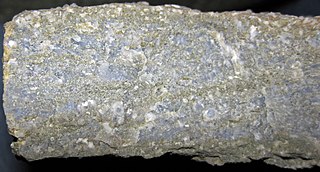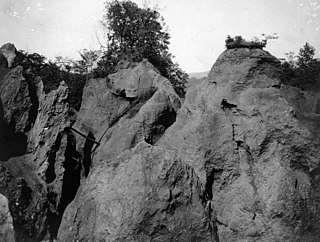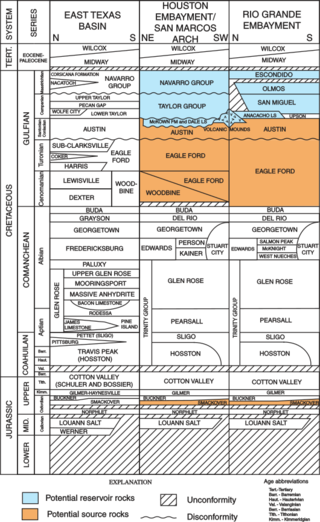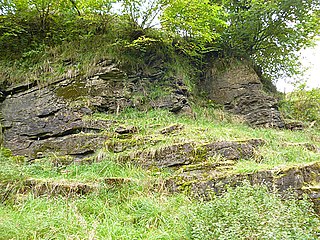This is a list of fossiliferous stratigraphic units in Somalia .
This is a list of fossiliferous stratigraphic units in Somalia .

The Aymestry Limestone is a fossiliferous limestone of Gorstian age deposited in a warm shallow sea near the eastern margin of the Iapetus Ocean. It occurs in England in the Ludlow Group, between the Upper and Lower Ludlow Shales. It derives its name from Aymestrey (sic), Herefordshire, where it may be seen on both sides of the River Lugg. It is well developed in the neighbourhood of Ludlow and occupies a similar position in the Ludlow shales at Woolhope, the Abberley Hills, May Hill and the Malvern Hills.

The Fort Payne Formation, or Fort Payne Chert, is a geologic formation found in the southeastern region of the United States. It is a Mississippian Period cherty limestone, that overlies the Chattanooga Shale, and underlies the St. Louis Limestone. To the north, it grades into the siltstone Borden Formation. It preserves fossils dating back to the Carboniferous period.

The Hinton Formation is a geologic formation in West Virginia. It preserves fossils dating back to the Carboniferous period. It is mainly made up of limestone, sandstone, and shale.

The Whitewater Formation is a geologic formation in Ohio and Indiana. It preserves fossils dating back to the Ordovician period.

The Harrodsburg Limestone is a geologic formation, a member of the Sanders Group of Indiana Limestone, of Mississippian age. It was named for Harrodsburg in southern Monroe County, Indiana by T. C. Hopkins and C. E. Siebenthal. It is made up primarily of calcarenite and calcirudite. It also may include some beds of dolomite and shale.
The Linton Formation is a geologic formation in Indiana. It is the lower formation in the Carbondale Group, and includes six named members, "which, in ascending order, are the Seelyville Coal, Coxville Sandstone, Colchester Coal, Mecca Quarry Shale, Velpen Limestone, and Survant Coal Members, and unnamed units of sandstone, shale, and clay".
The Osgood Formation, also known as the Osgood Shale is a geologic formation in Indiana, Kentucky, and Ohio. It preserves fossils dating back to the Silurian period.

The Waldron Shale is a geologic formation in Indiana. It preserves fossils dating back to the Silurian period.
The Whitesburg Formation is a dark limestone with interbedded shales geologic formation in Tennessee and Virginia. It preserves fossils dating back to the Ordovician period.

The Tomstown Dolomite or Tomstown Formation is a geologic formation in Maryland, Pennsylvania, Virginia and West Virginia. It preserves fossils dating to the Cambrian Period.
The Genesee Group is a geologic formation in Pennsylvania. It preserves fossils dating back to the Devonian period.
The Tallahatta Formation is a geologic formation found on the surface in Alabama, Florida, Georgia, and Mississippi. It is also located in the subsurface of Kentucky. The Tallahatta formation is part of the Claiborne Group and contains four members: the Basic City Shale in Mississippi, the Holy Springs Sand Member in Mississippi, the Meridian Sand Member in Alabama and Mississippi, and the Neshoba Sand Member in Mississippi. It preserves fossils dating back to the Paleogene period, specifically the Eocene.

The Hammett Shale is a geologic formation in Texas. It preserves fossils dating back to the Cretaceous period.

The Gros Ventre Formation is a geologic formation in Wyoming, USA. It preserves fossils dating back to the Cambrian period. The Gros Ventre consists of three main members; the Wolsey Shale, the Death Canyon Limestone, and the Park Shale.
The Mount Whyte Formation is a stratigraphic unit that is present on the western edge of the Western Canada Sedimentary Basin in the southern Canadian Rockies and the adjacent southwestern Alberta plains. It was deposited during Middle Cambrian time and consists of shale interbedded with other siliciclastic rock types and limestones. It was named for Mount Whyte in Banff National Park by Charles Doolittle Walcott, the discoverer of the Burgess shale fossils, and it includes several genera of fossil trilobites.

The Dent Group is a group of Upper Ordovician sedimentary and volcanic rocks in north-west England. It is the lowermost part of the Windermere Supergroup, which was deposited in the foreland basin formed during the collision between Laurentia and Avalonia. It lies unconformably on the Borrowdale Volcanic Group. This unit was previously known as the Coniston Limestone Group or Coniston Limestone Formation and should not be confused with the significantly younger Coniston Group.

The East Kirkton Limestone is a rock unit in the West Lothian Oil-Shale Formation in Scotland. It preserves fossils of the Carboniferous period. The limestone outcrops at East Kirkton Quarry.
The Kössen Formation is a Late Triassic (Rhaetian-age) geological formation in the Northern Calcareous Alps of Austria and Germany, in the Tiroler-Lech Nature Park. During the Late Triassic, the area now occupied by the Northern Calcareous Alps was instead a long, passive coastline at the western tip of the Neotethys Ocean. The environment was initially dominated by a wide and shallow carbonate platform within a lagoon between the shore and a string of reefs. This carbonate platform is nowadays preserved as the Carnian to Norian-age Hauptdolomit and Dachstein Formation. The Kössen Formation represents a period of increased siliciclastic clay input into the lagoon, covering up the carbonate platform with marls and marly limestones instead of pure limestone or dolomite. The Eiberg Member of the Kössen Formation was deposited in the Eiberg basin, a narrow strip of deeper water which developed between the carbonate platform and the shoreline in the later part of the Rhaetian.
The Huntersville Chert or Huntersville Formation is a Devonian geologic formation in the Appalachian region of the United States. It is primarily composed of mottled white, yellow, and dark grey chert, and is separated from the underlying Oriskany Sandstone by an unconformity. The Huntersville Chert is laterally equivalent to the Needmore Shale, which lies north of the New River. It is also laterally equivalent to a sandy limestone unit which is often equated with the Onondaga Limestone. These formations are placed in the Onesquethaw Stage of Appalachian chronostratigraphy, roughly equivalent to the Emsian and Eifelian stages of the broader Devonian system.